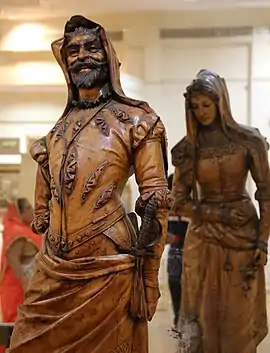Mephistopheles and Margaretta
Mephistopheles and Margaretta is a 19th-century wooden "double sculpture" of two characters from Johann Wolfgang von Goethe's 1808 play Faust. The obverse depicts the demon Mephistopheles, and the reverse depicts a woman, Margaretta (Margaret, or Gretchen). A mirror placed behind the sculpture allows both sides to be seen simultaneously.
| Mephistopheles and Margaretta | |
|---|---|
 Mephistopheles and Margaretta, with the reverse visible in a mirror | |
| Completion date | c. 1876[1] |
| Medium | Sycamore wood |
| Subject | Characters from Goethe's Faust |
| Dimensions | 177.2 cm (69.8 in) |
| Location | Salar Jung Museum, Hyderabad, India |
Background
The sculpture was acquired in France by the Indian nobleman Mir Turab Ali Khan, Salar Jung I, in 1876,[1] and now resides in the Salar Jung Museum in Hyderabad, India.[2] The museum is one of the most visited in the country, and claims one million visitors annually.[3]
The statue reflects the themes of good and evil in Faust.[1] In the play, Faust is frustrated with his life and attempts suicide. He calls for Satan's help, and the demon Mephistopheles, an agent of Satan, responds. Faust is told that Mephistopheles will serve him as long as he lives, but after his death, Faust would forfeit his soul and become enslaved forever.[4] He agrees, making a deal with the Devil, and as one of his requests for magic, Mephistopheles seduces a young woman named Gretchen (Margaretta) for Faust. She is impregnated by Faust and gives birth to his bastard son. Gretchen realizes the evil in the situation and drowns the child, and is held in jail on the charge of murder. Gretchen is hanged but is allowed to go to heaven; Faust is also saved by God because of Gretchen's pleadings.[4]
Sculpture

The 19th-century sculpture was created by an unknown French sculptor, carved into a block of sycamore wood.[5] The obverse is a depiction of a confident and arrogant Mephistopheles,[6] wearing a hood and boots, and with a smirk on his long face.[7] The reverse is of Gretchen with her head bowed,[6] appearing as a simple girl with downcast eyes.[7]
The statue is carved from one single block of wood and is exhibited with a mirror placed behind it, allowing viewers to observe both sides at the same time.[2] The dichotomy of good and evil is emphasized by the innocence of the female figure, a demure woman holding a prayer book in her hand, contrasting with the depiction of evil exemplified by Mephistopheles.[5][1]
References
- "Salar Jung Museum's 'Double Statue'". Live History India. 26 July 2019. Archived from the original on 10 February 2022. Retrieved 10 February 2022.
- Srinivas, Susheela (2 March 2019). "Mystical masterpieces". Deccan Herald. Archived from the original on 10 February 2022. Retrieved 10 February 2022.
- Mathur, Saloni; Singh, Kavita (2015). No touching, no spitting, no praying : the museum in South Asia. New Delhi: Routledge. pp. 244–245. ISBN 978-1-138-79601-0. Archived from the original on 26 February 2022. Retrieved 11 February 2022.
- Goethe, Johann Wolfgang von (1985). Faust, part I (Rev. ed.). New York: Bantam Books. pp. 1–433. ISBN 978-0-553-21348-5. Archived from the original on 26 February 2022. Retrieved 10 February 2022.
- Sripada, Krishna (31 August 2017). "An all-season destination". The Hindu. Archived from the original on 10 February 2022. Retrieved 10 February 2022.
- Stewart, Jessica (6 November 2019). "This 19th-Century "Double Sculpture" Tells a Tale of Two Different People on Back and Front". My Modern Met. Archived from the original on 10 February 2022. Retrieved 10 February 2022.
- Haseeb, Ahssanuddin (27 February 2019). "A Virtual Tour With A Difference Of 'Salarjung Museum' In Hyderabad". Hyderabad News. Archived from the original on 11 February 2022. Retrieved 11 February 2022.
External links
| Wikimedia Commons has media related to Mephistopheles & Margaretta statue (Hyderabad). |